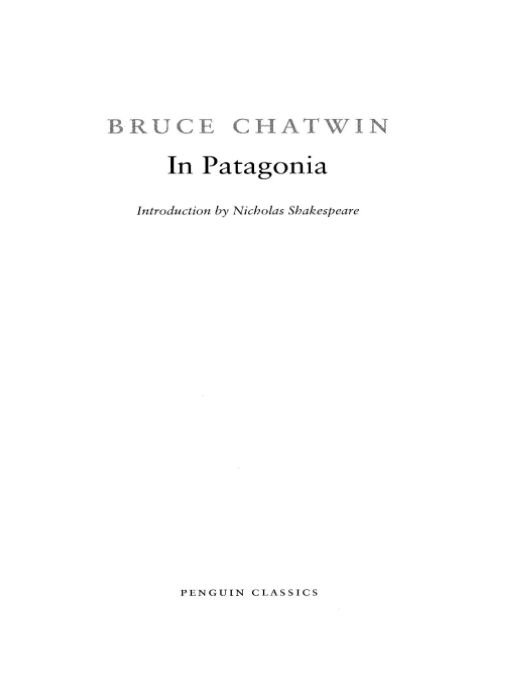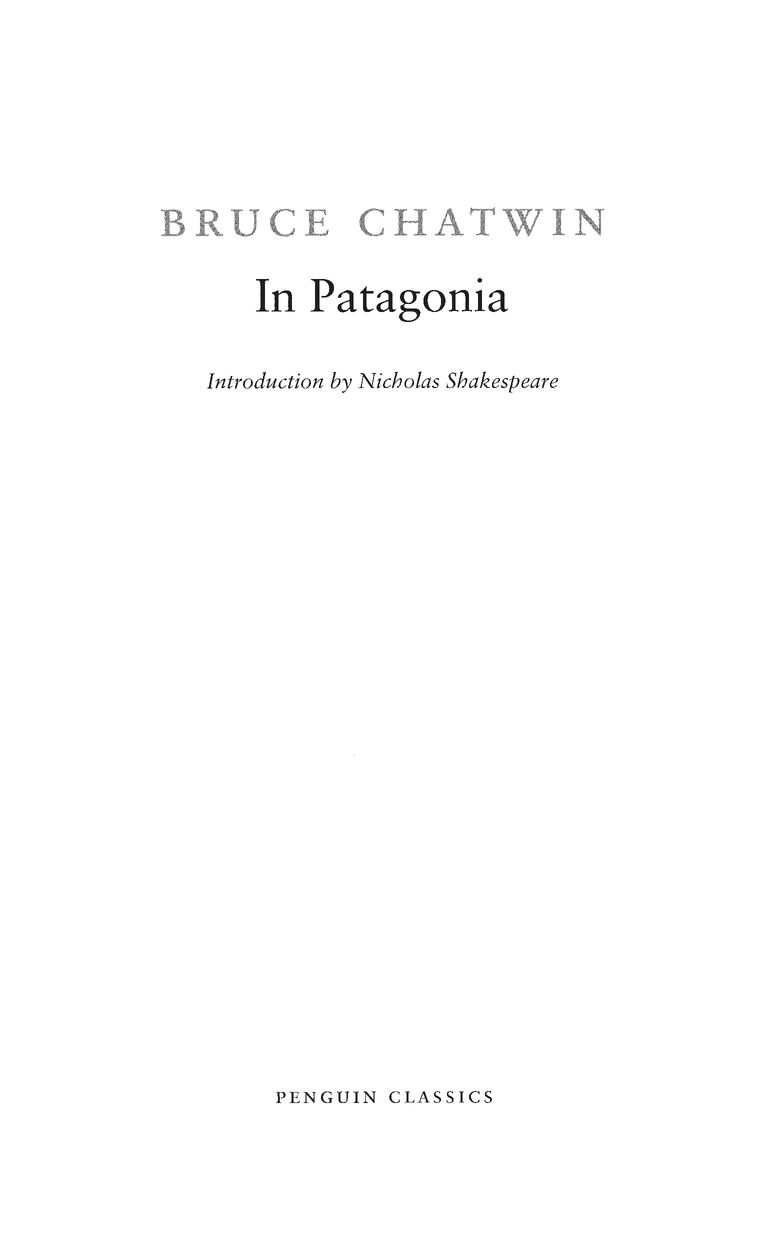In Patagonia
Authors: Bruce Chatwin


Table of Contents
Â
Â
Â

IN PATAGONIA
Bruce Chatwin was born in 1940, and was the author of
In Patagonia, The Viceroy of Ouidah, On the Black Hill, The Songlines
, and
Utz
. The last three he considered works of fiction. His other books are
What Am I Doing Here, Anatomy of Restlessness,
and
Far Journeys
, a collection of his photographs that also includes selections from his travel notebooks. Chatwin died outside Nice, France, on January 17, 1989.
In Patagonia, The Viceroy of Ouidah, On the Black Hill, The Songlines
, and
Utz
. The last three he considered works of fiction. His other books are
What Am I Doing Here, Anatomy of Restlessness,
and
Far Journeys
, a collection of his photographs that also includes selections from his travel notebooks. Chatwin died outside Nice, France, on January 17, 1989.
Â
Nicholas Shakespeare wrote a biography of Bruce Chatwin that was published in 2000. He is also the author of
The Vision of Elena Silves
, winner of the Somerset Maugham Award;
The High Flyer
, for which he was nominated one of
Granta's
Best of Young British novelists in 1993; and
The Dancer Upstairs
.
The Vision of Elena Silves
, winner of the Somerset Maugham Award;
The High Flyer
, for which he was nominated one of
Granta's
Best of Young British novelists in 1993; and
The Dancer Upstairs
.


PENGUIN BOOKS
Published by the Penguin Group
Penguin Group (USA) Inc., 375 Hudson Street, New York, New York 10014, U.S.A.
Penguin Group (Canada), 90 Eglinton Avenue East, Suite 700, Toronto,
Ontario, Canada M4P 2Y3 (a division of Pearson Penguin Canada Inc.)
Penguin Books Ltd, 80 Strand, London WC2R ORL, England
Penguin Ireland, 25 St Stephen's Green, Dublin 2, Ireland (a division of Penguin Books Ltd)
Penguin Group (Australia), 250 Camberwell Road, Camberwell,
Victoria 3124, Australia (a division of Pearson Australia Group Pty Ltd)
Penguin Books India Pvt Ltd, 11 Community Centre, Panchsheel Park, New Delhiâ110 017, India
Penguin Group (NZ), cnr Airborne and Rosedale Roads,
Albany, Auckland 1310, New Zealand (a division of Pearson New Zealand Ltd)
Penguin Books (South Africa) (Pty) Ltd, 24 Sturdee Avenue,
Rosebank, Johannesburg 2196, South Africa
Penguin Group (USA) Inc., 375 Hudson Street, New York, New York 10014, U.S.A.
Penguin Group (Canada), 90 Eglinton Avenue East, Suite 700, Toronto,
Ontario, Canada M4P 2Y3 (a division of Pearson Penguin Canada Inc.)
Penguin Books Ltd, 80 Strand, London WC2R ORL, England
Penguin Ireland, 25 St Stephen's Green, Dublin 2, Ireland (a division of Penguin Books Ltd)
Penguin Group (Australia), 250 Camberwell Road, Camberwell,
Victoria 3124, Australia (a division of Pearson Australia Group Pty Ltd)
Penguin Books India Pvt Ltd, 11 Community Centre, Panchsheel Park, New Delhiâ110 017, India
Penguin Group (NZ), cnr Airborne and Rosedale Roads,
Albany, Auckland 1310, New Zealand (a division of Pearson New Zealand Ltd)
Penguin Books (South Africa) (Pty) Ltd, 24 Sturdee Avenue,
Rosebank, Johannesburg 2196, South Africa
Â
Penguin Books Ltd, Registered Offices: 80 Strand, London WC2R 0RL, England
Â
First published in Great Britain by Jonathan Cape Ltd. 1977
First published in the United States of America by Summit Books,
a division of Simon & Schuster, Inc. 1979
Published in Penguin Books 1988
This edition with an introduction by Nicholas Shakespeare published 2003
First published in the United States of America by Summit Books,
a division of Simon & Schuster, Inc. 1979
Published in Penguin Books 1988
This edition with an introduction by Nicholas Shakespeare published 2003
Â
Copyright © Bruce Chatwin, 1977Sections 73, 75, 86 Copyright © Monica Barnett, 1977
Introduction copyright © Nicholas Shakespeare, 2003
All rights reserved
Introduction copyright © Nicholas Shakespeare, 2003
All rights reserved
Â
LIBRARY OF CONGRESS CATALOGING-IN-PUBLICATION DATA
Â
Chatwin Bruce, 1942-1989
In Patagonia.
In Patagonia.
Reprint. Originally published : New York : Summit Books, CI977. 1. Patagonia (Argentina and Chile)âDescription and travel. 2. Chatwin, Bruce, 1942-1989âJourneysâPatagonia (Argentina and Chile). I. Title. [F2936.C47 1988] 918.2'70464 87-38485
eISBN : 978-1-101-50314-0
Â
3
Â
Â
The scanning, uploading and distribution of this book via the Internet or via any other means without the permission of the publisher is illegal and punishable by law. Please purchase only authorized electronic editions, and do not participate in or encourage electronic piracy of copyrighted materials. Your support of the author's rights is appreciated.
In Patagonia:
an introduction,
an introduction,
by Nicholas Shakespeare
Â
Â
Â
Â
In December 1974, the 34-year-old Bruce Chatwin departed Buenos Aires on the night bus south, beginning a journey that would transform a truant journalist to one of the most stylish and original writers of the late twentieth century. That same year, almost to the day, I left school to work as a cowhand in the Buenos Aires province. To the south, the plains spread on and on into Patagonia.
I was seventeen and, of course, it scored me. With my head full of all that empty space, I returned ten months later to tiny, congested England. I instantly forgot the flies, the saddle sores, the boredom. I was desperate to go back.
Six years later, I created an opportunity and traveled through Rio Negro and Chubut to Tierra del Fuego. The military junta had erected signs beside the roadsâ“To know Patagonia is a duty”âbut no one was taking notice. Patagonia, in the estimation of one Buenos Aires writer, was “just emptinessâa back alley where different cultures swirled about and rather a boring place.”
One morning, in a gesture soon to be repeated by a generation of backpackers, I was waiting for a bus in the dusty scrubland west of Trelew when I dug out a book I'd brought with me, a paperback edition that today bears the creases and marginalia of three visits to Patagonia.
I'd never heard of the author, but his was the only contemporary book I could find about my destination. I opened the first page and I read the first paragraph and that, really, was that.

Patagonia is not a precise region on the map. It is a vast, vague territory that encompasses 900,000 square kilometers of Argentina and Chile. The area is most effectively defined by its soil. You know you are in Patagonia when you see
rodados patagonicos,
the basalt pebbles left behind by glaciers, and
jarilla,
the low bush that is its dominant flora. Patagonia may also be described by its climate. The wind that blows with terrific force from October to Marchâin Chatwin's expression, “stripping men to the raw”âmade Antoine de Saint-Exupéry's plane fly backward instead of forward.
rodados patagonicos,
the basalt pebbles left behind by glaciers, and
jarilla,
the low bush that is its dominant flora. Patagonia may also be described by its climate. The wind that blows with terrific force from October to Marchâin Chatwin's expression, “stripping men to the raw”âmade Antoine de Saint-Exupéry's plane fly backward instead of forward.
Travelers from Darwin onward have noted how this bleakness seizes the imagination. Patagonia's nothingness forces the mind in on itself. In the museum of Trelew I'd found the diary of a stern Welsh pioneer. John Murray Thomas, trekking inland in July 1877, wrote in his fading pencil: “Last night dreamt of Harriett that we were in the bedroom. Had a nice kiss. Hardly a night passes but that I see her in my dreams.”
Other books
Devotion by Marianne Evans
Love in Neverland: Book 2 in The Neverland Trilogy by Heather C. Myers
Every Little Piece by Kate Ashton
Christmas With Mr. Jeffers by Julie Kavanagh
The Bonner Incident: Joshua's War by Thomas A Watson, Michael L Rider
Love Beyond Words (City Lights: San Francisco Book 1) by Scott, Emma
Trouble by Samantha Towle
A World Without Heroes by Brandon Mull
Back to Vanilla by Jennifer Maschek
Theta Waves Book 1 (Episodes 1-3) by Atkinson, Thea
